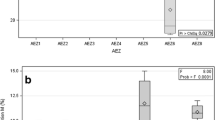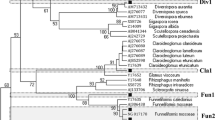Abstract
Analysis of the community of arbuscular mycorrhizal (AM) fungi in roots of Fragaria vesca growing in a heavy metal contaminated site was carried out on a Zn waste site near Chrzanow (southern Poland). The waste substratum was characterized by high contents of Pb, Zn, Cd, Cu and As, and by low levels of N, P and organic matter. Spores of Glomales were isolated by wet sieving and DNA was isolated from individual spores. Nested polymerase chain reaction (PCR) with taxon-specific primers was used to identify the species Glomus mosseae, Glomus intraradices and Glomus claroideum. Spores of other fungi were morphologically characterized and new taxon-discriminating molecular probes were developed for two of them (Glomus sp. HM-CL4 and HM-CL5) based on variations in the large ribosomal subunit (25S rDNA). High sequence similarities were found between Glomus sp. HM-CL4 and Glomus gerdemanii, and between Glomus sp. HM-CL5 and Glomus occultum. The designed primers were used to characterize the population of AM fungi colonizing the roots of F. vesca collected from the Zn waste site. The analysis, carried out on roots stained with trypan blue, showed that the most effective colonizer was closely related to G. gerdemannii. G. claroideum and the G. occultum-like fungus were slightly less common whilst frequencies of G. intraradices and G. mosseae in roots were much lower. The analysis of mycorrhiza stained with rhodizoniate to localize heavy metal accumulation showed that the stain does not influence the PCR reaction. Seventy percent of the root samples containing positively stained fungal hyphae were found to be colonized by G. mosseae. The data obtained demonstrate the usefulness of nested PCR for studies carried out in polluted areas. It will enable selection of AM fungi which are able to colonize plant roots under heavy metal stress conditions, as well as the identification of fungi showing high in situ accumulation of potentially toxic elements.
Similar content being viewed by others
Author information
Authors and Affiliations
Corresponding author
Additional information
Accepted: 7 July 2000
Rights and permissions
About this article
Cite this article
Turnau, K., Ryszka, P., Gianinazzi-Pearson, V. et al. Identification of arbuscular mycorrhizal fungi in soils and roots of plants colonizing zinc wastes in southern Poland. Mycorrhiza 10, 169–174 (2001). https://doi.org/10.1007/s005720000073
Published:
Issue Date:
DOI: https://doi.org/10.1007/s005720000073




